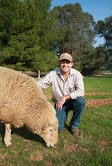The health benefits of lamb and beef could be boosted by feeding livestock forage crops with higher levels of omega-3 fatty acids, according to the NSW Department of Primary Industries.
A review of omega-3 research published through the Graham Centre — an alliance between NSW DPI and Charles Sturt University — has highlighted gaps in information that could contribute to giving consumers healthier options in their protein choices.
The alliance found that more information on omega-3 concentration in forages grown in Australia and the factors that increase these levels would allow producers to select forages and production systems to maximise omega-3 in red meat.
Scientific evidence has also shown that omega-3 levels in feed can be managed to influence livestock reproduction, including sex ratios in sheep, NSW DPI said.
New livestock feed management options
The NSW researchers have identified new livestock feed management options that may boost levels of omega-3 fatty acids in Australian red meat to benefit human and livestock health.
This includes better integration of plant-based food into the diets of cattle and sheep to produce higher levels of omega-3 delivered to consumers as a natural benefit of eating beef and lamb.
Wagga Wagga Agricultural Institute DPI livestock research officer, Ed Clayton, said red meat already contributed about 40 percent of the average daily intake of long-chain omega-3 polyunsaturated acids (LCn-3PUFA) for adult men and women in Australia.
“Most Australian beef and lamb production is based on pasture and grass-fed systems, providing relatively lean meat cuts which are also sources of omega-3.
“There’s potential to significantly increase the consumption of health-claimable fatty acids from red meat by using forage with higher levels of available omega-3,” Dr Clayton said.
“During seasonal feed gaps and in dry times, grain is often used to supplement their diets and finish animals for sale – the key to improving the health aspects of beef and lamb is to optimise the forage content in their diets.”
Fresh forage and silage is high priority
Dr Clayton said there are many opportunities to include fresh forage and silage in production systems, even when animals are grain-fed in feedlots.
“Fresh forage or high quality silage that meets market specifications for the efficient production of high-quality meat remains a high priority,” he said.
“The ability of forage to maximise the amount of omega-3 depends on the nature of the forage – generally fresh forage provides more omega-3 than hay or silage, but there is scope to increase the amount of omega-3 available in silage.
“Omega-3 levels can be maximised in silage by processes which limit wilting and ensure the most efficient fermentation takes place.”
Source: NSW DPI




Interesting article. Since animal and plant nutrition is directly associated with food quality, further research should take place to determine the best possible combination of nutrients to be given to cattle and cops in order to enhance the nutritional profile of fresh food.
Wonderful news. I have written in detail about the problems associated with grain feeding animals and its negative effect on their health and the knock-on effects on ours, on my web site http://www.primalmeats.co.uk/grass-fed-meat-does-it-really-matter